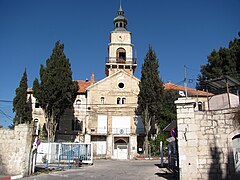Schneller Orphanage
| Schneller Orphanage | |
|---|---|
| German: Syrisches Waisenhaus | |

Schneller Orphanage main building
|
|
| Alternative names | Syrian Orphanage |
| General information | |
| Type | Orphanage |
| Architectural style | South German |
| Location | 34 Malkhei Yisrael Street Jerusalem |
| Country | Israel |
| Coordinates | 31°47′27″N 35°12′46″E / 31.7908°N 35.2127°ECoordinates: 31°47′27″N 35°12′46″E / 31.7908°N 35.2127°E |
| Current tenants | none |
| Construction started | 1855 |
| Inaugurated | 1856 |
| Design and construction | |
| Architect | Johann Ludwig Schneller |
Schneller Orphanage, also called the Syrian Orphanage, was a German Protestant orphanage that operated in Jerusalem from 1860 to 1940. It was one of the first structures to be built outside the Old City of Jerusalem (the others are Mishkenot Sha’ananim and the Russian Compound) and paved the way for the expansion of Jerusalem in the 19th century. As a philanthropic institution offering academic and vocational training to hundreds of orphaned and abandoned Arab children, it also exerted a strong influence on the Arab population of Jerusalem and the Middle East through its graduates, who spread its philosophies of "orderliness, discipline, and German language" throughout the region. The Syrian Orphanage was born out of South German Pietism, which combined Biblicism, idealism, and religious individualism
The orphanage provided both academic and vocational training to orphaned boys and girls from Palestine, Syria, Egypt, Ethiopia, Armenia, Turkey, Russia, Iran, and Germany, graduating students skilled in such trades as tailoring, shoemaking, engraving, carpentry, metalworking, pottery, painting, printing, farming, and gardening. In 1903 a school for the blind was opened on the premises, including dormitories, classrooms and vocational workshops. The orphanage also operated its own printing press and bindery; flour mill and bakery; laundry and clothing-repair service; carpentry; pottery factory; tree and plant nursery; and brick and tile factory. Located on high ground and surrounded by a high stone wall, the orphanage's distinctive onion-dome tower, multistory buildings, and decorative facades exuded the power and influence of European Christians in Jerusalem in the mid-19th century.
...
Wikipedia
